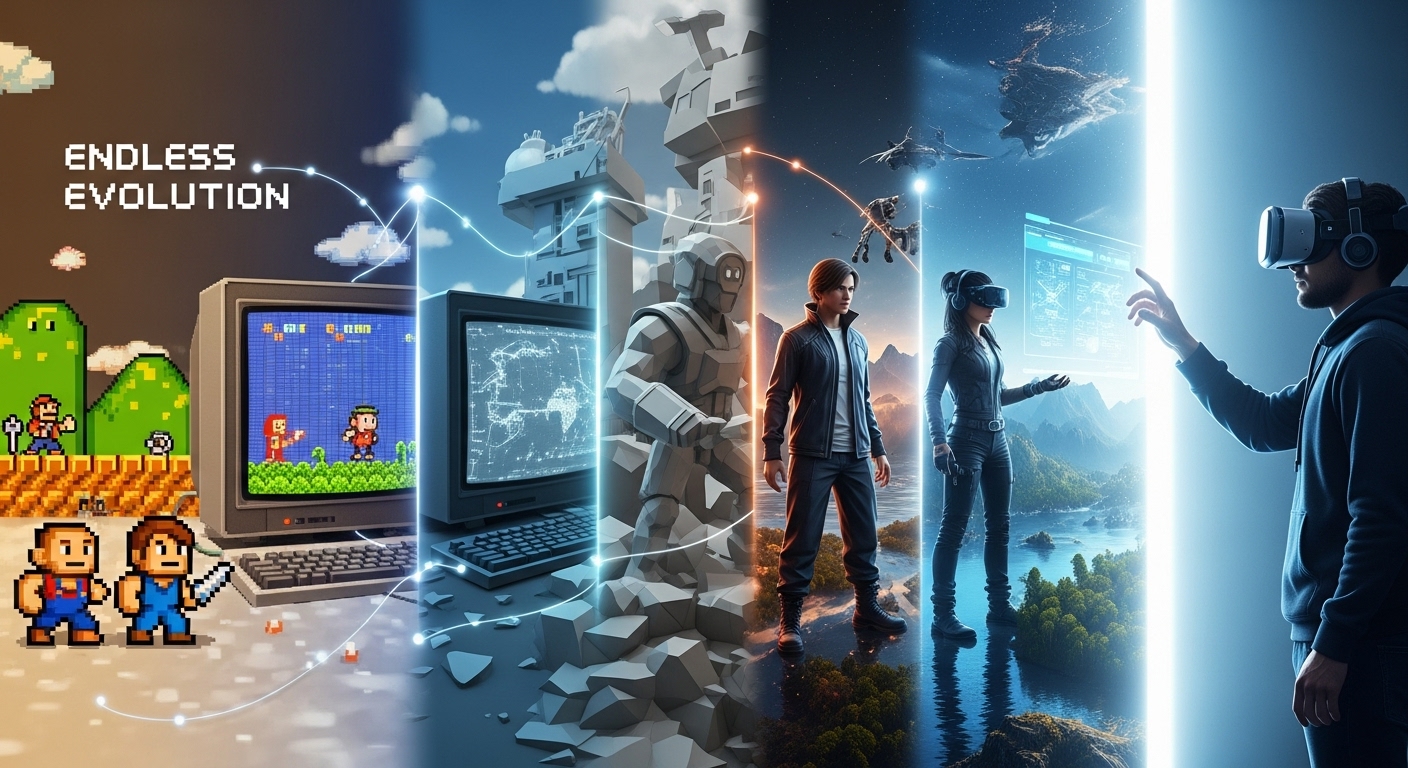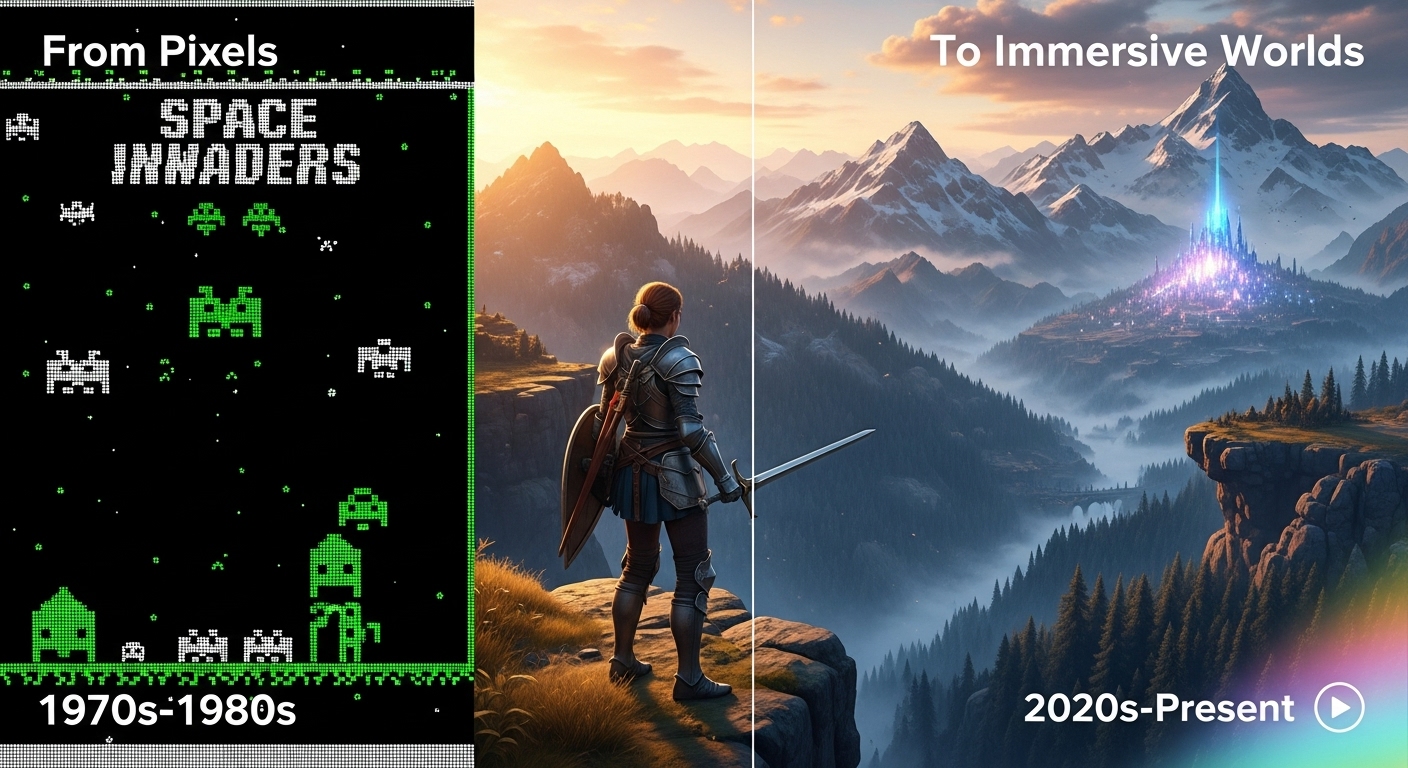Gaming has come a long way since its humble beginnings. What started as simple pixelated entertainment has now transformed into a multi-billion-dollar industry that influences culture, technology, and social interaction. From retro arcades to virtual reality, gaming has continuously evolved, captivating millions of players worldwide. This blog explores the history, trends, impacts, and future of gaming, highlighting why it has become an integral part of modern life.
The Birth of Video Games
The story of gaming begins in the 1950s and 1960s, when researchers and engineers started experimenting with computer-based entertainment. One of the earliest known games was “Tennis for Two,” created in 1958 by physicist William Higinbotham. Using an oscilloscope, Higinbotham designed a simple tennis simulation that allowed two players to control paddles on a screen. Although primitive, it laid the groundwork for what would eventually become the video game industry.
In 1962, MIT students developed “Spacewar!”, a game that ran on a PDP-1 computer. Players controlled spaceships and fired missiles at each other, showcasing both creativity and competitive play. This game marked the beginning of interactive digital entertainment, inspiring future game designers to experiment with mechanics, storytelling, and technology.
The Rise of Arcade Games
The 1970s and 1980s were the golden age of arcade games. Titles like Pong, Pac-Man, and Space Invaders dominated arcades worldwide. These games were simple in design but highly addictive, encouraging players to compete for high scores. Arcades became social hubs, offering not just gaming experiences but also opportunities for community and competition.
During this era, game developers began experimenting with different genres. Shooters, platformers, and maze games became popular, each introducing unique gameplay mechanics. The rise of arcades also gave birth to professional gaming in its earliest form, as players sought recognition for their skill and precision.
Home Consoles Revolutionize Gaming
While arcades were thriving, home gaming started to gain traction. The release of the Atari 2600 in 1977 marked a pivotal moment, bringing video games into living rooms. For the first time, people could enjoy interactive entertainment without leaving home. Home consoles allowed for longer gameplay, customization, and personal investment in gaming experiences.
The 1980s also saw the emergence of iconic franchises like Super Mario Bros., The Legend of Zelda, and Metroid. These games combined engaging narratives with innovative gameplay, proving that video games could be more than just a casual pastime—they could tell stories and immerse players in entire worlds.
The Era of PC Gaming
While consoles were making waves, PC gaming was quietly growing in popularity. Personal computers offered flexibility, better graphics, and more complex game mechanics. Games like Myst, Doom, and Civilization showcased the potential of PCs as gaming platforms, offering immersive experiences that were difficult to replicate on consoles.
PC gaming also fostered communities in unprecedented ways. Online multiplayer games, chat forums, and fan-created content allowed players to connect, collaborate, and compete on a global scale. The advent of the internet further accelerated PC gaming, laying the foundation for modern esports and online communities.
The Evolution of Graphics and Technology
One of the most significant changes in gaming over the decades has been the evolution of graphics. Early games relied on simple sprites and pixel art, constrained by hardware limitations. As technology improved, games transitioned to 3D graphics, realistic textures, and detailed environments.
The introduction of 3D graphics engines in the 1990s, such as the one used in Quake and Tomb Raider, revolutionized game design. Players could now explore immersive worlds, interact with realistic characters, and experience cinematic storytelling. Today, cutting-edge graphics, ray tracing, and virtual reality push the boundaries of realism, blurring the line between gaming and real life.
Mobile Gaming: Gaming in Your Pocket
The rise of smartphones has transformed gaming once again. Mobile gaming allows players to engage with games anytime, anywhere, reaching an audience that traditional consoles could not. Titles like Angry Birds, Candy Crush, and Clash of Clans became cultural phenomena, proving that casual games can be both profitable and addictive.
Mobile gaming also democratized access to video games. Unlike expensive consoles or high-end PCs, smartphones are widely available, allowing people from all backgrounds to participate in gaming. This shift has influenced game design, emphasizing short sessions, social interaction, and in-app purchases to sustain engagement.
The Social Impact of Gaming
Gaming is more than just entertainment—it’s a social phenomenon. Multiplayer games, online communities, and streaming platforms have transformed gaming into a shared experience. Players connect globally, forming friendships, teams, and fan communities. Games like Fortnite and Minecraft are social spaces where collaboration, creativity, and competition coexist.
Streaming platforms such as Twitch and YouTube Gaming have also turned gaming into a spectator sport. Professional gamers can earn incomes from streaming, sponsorships, and tournaments, highlighting gaming’s economic potential. The social aspect of gaming continues to grow, influencing culture, trends, and even communication styles.
Esports: Competitive Gaming at Its Peak
Esports, or professional competitive gaming, has skyrocketed in recent years. Games like League of Legends, Counter-Strike: Global Offensive, and Dota 2 attract millions of viewers and offer multi-million-dollar prize pools. Esports tournaments are held in stadiums, broadcast online, and followed by fans around the world, comparable to traditional sports leagues.
Esports also fosters skill, strategy, and teamwork. Professional players dedicate hours to training, analyzing gameplay, and refining techniques. This growing industry has created career opportunities, from players to coaches, commentators, and game developers, cementing gaming as a legitimate profession.
Gaming and Storytelling
One of the most fascinating aspects of modern gaming is storytelling. Games are no longer just about points, levels, or scores—they tell compelling narratives that rival movies and novels. Titles like The Last of Us, Red Dead Redemption 2, and The Witcher 3 immerse players in rich worlds with complex characters, moral dilemmas, and branching storylines.
Interactive storytelling gives players agency, allowing choices to influence outcomes. This engagement fosters emotional investment and creates memorable experiences. As narrative design continues to evolve, games will increasingly become a medium for artistic expression, exploring themes that resonate with players on a personal level.
Virtual Reality and Augmented Reality
The advent of virtual reality (VR) and augmented reality (AR) has opened new frontiers in gaming. VR offers fully immersive experiences, placing players inside the game world with headsets, motion controllers, and haptic feedback. Games like Beat Saber, Half-Life: Alyx, and No Man’s Sky VR demonstrate the potential of this technology to transform gameplay.
AR games, on the other hand, blend digital elements with the real world. Pokemon Go is a prime example, encouraging players to explore their surroundings while interacting with virtual creatures. These technologies are not just novelties—they have the potential to redefine how we play, learn, and interact with digital content.
Gaming as a Tool for Learning and Development
Beyond entertainment, gaming has educational and cognitive benefits. Strategy games, puzzles, and simulation games can enhance problem-solving, critical thinking, and decision-making skills. Games like Civilization teach history and strategy, while flight simulators provide practical training for pilots.
Educational games and gamified learning platforms leverage game mechanics to make learning engaging. By rewarding progress, encouraging experimentation, and providing instant feedback, games can enhance retention and motivation. Gaming is increasingly recognized as a tool for personal development, skill acquisition, and mental stimulation.
The Business of Gaming
The gaming industry is now a global economic powerhouse. Revenue streams include console and PC sales, digital downloads, in-game purchases, subscriptions, and esports tournaments. Companies like Sony, Microsoft, Nintendo, and Tencent dominate the market, constantly innovating to capture player attention.
Monetization strategies have evolved alongside gaming trends. Free-to-play models with microtransactions dominate mobile and online gaming, while subscription services like Xbox Game Pass provide access to extensive game libraries. The business of gaming demonstrates a delicate balance between profitability and player satisfaction, driving continuous innovation.
Gaming Culture and Community
Gaming has developed its own vibrant culture, encompassing art, music, memes, and social norms. Communities form around shared interests, fan creations, and competitive play. Cosplay, fan art, and conventions celebrate games as cultural artifacts, highlighting the impact of gaming beyond the screen.
Online communities foster collaboration and creativity. Players share strategies, mod games, and participate in forums. This culture encourages social interaction, innovation, and collective storytelling, making gaming a dynamic and participatory medium.
The Future of Gaming
Looking ahead, gaming will continue to evolve in exciting ways. Advancements in artificial intelligence, cloud gaming, and machine learning will enable smarter NPCs, seamless multiplayer experiences, and adaptive gameplay. Virtual worlds will become more immersive, interconnected, and persistent, blurring the boundaries between reality and fantasy.
The future may also see greater inclusivity, accessibility, and diversity in gaming. Developers are creating experiences that cater to different abilities, backgrounds, and perspectives, making gaming more welcoming for everyone. As technology and culture evolve together, gaming will remain at the forefront of innovation, creativity, and human connection.
Conclusion
Gaming is no longer just a pastime—it is a cultural phenomenon, a technological marvel, and a source of community, creativity, and economic opportunity. From its early experiments in computer labs to the fully immersive worlds of VR and cloud gaming, it has continuously pushed boundaries and captivated players worldwide. As the industry grows and evolves, gaming will continue to inspire, challenge, and connect people, offering experiences that transcend screens and pixels.
The journey of gaming is a testament to human imagination, innovation, and the enduring appeal of play. Whether you are a casual mobile gamer, a competitive esports player, or a dedicated fan of narrative-driven games, there is no denying the profound impact gaming has had—and will continue to have—on our world.



